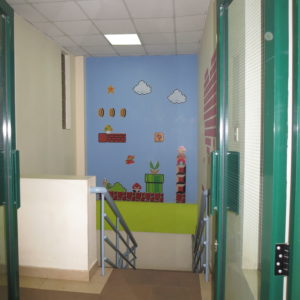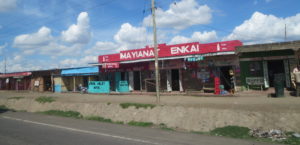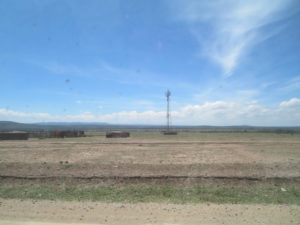
One of the most striking things about Kenya was what a blend of the future and the past it represented in almost every location, all swirled up in one moment of technology and tradition.
The iHub was in a way a space out of time or place. The welcome mats read “There’s no place like 127.0.0.1”, as if I’d never left Silicon Valley years ago. There was a mural of the original Mario Brothers game on the wall in the staircase. And dozens of programmers (both genders), with the stickers on their laptops surely familiar to Western programmers. There were even 2 coffee bars in the building.
And yet, when you stood on the 4th floor terrace and looked out at the city, you needed to look no further than nearby construction to see things going in a much more traditional way. A building constructed with a wooden frame (unfinished tree limbs) instead of steel or lumber, and the construction workers hanging off of the side unsecured. In the distance, a large column of smoke that turned out to be an entire neighborhood burning down.
As it turned out, we were also at the whim of the past – that construction site (or another one nearby) ended up digging too deep, and cutting the connectivity to the iHub for most of the week. They fell back to what I believe was a DSL line, but it didn’t go far with dozens of people trying to connect at once.
Even more striking, though, was the presence of technology as we drove towards the Maasai Mara game reserve. Once you left the Nairobi city limits, things became rural very quickly. The scenery transitioned from apartment buildings and shopping centers to smaller villages consisting of clusters of cinderblock buildings. Livestock wander the streets freely, along with the occasional zebra, antelope or even baboon. But those cinderblock buildings are far from dull. In fact, most are essentially billboards, handpainted in vibrant colors touting everything from Doublemint gum to drugstore painkillers. It seems that handpainting signs is a significant career option even now in Kenya.

The most common sight is buildings painted bright green or red. Some boast Safaricom SIM cards and plan top-ups. Others offer M-PESA virtual currency transactions and top-ups. Remarkably, both represent actual stores and services inside – even when those stores are in the middle of nowhere. Even when you have to walk past a herd of cows to get to the tiny storefront. It’s funny to see the handpainted signs touting a symbol of such significant technology.
The reach of the cellular networks is much farther than you’d think. I saw cell phone towers next to remote villages with mud and dung huts off a dirt road. We had some service deep in the middle of the game reserve. It’s hard to tell which came first – the ubiquitousness or the usefulness to folks in the outlying villages. I wonder how the system unfolded. But to an outside observer, it’s almost as if mobile phones have always been there, just like the cows and the goats.
Even more surprising was the fact that mobile phones are apparently far more reliable than landlines, which are so notoriously inconsistent that they are nearly unusable or untrustable. In a world where minutes are precious, and “bumping” is common (calling and hanging up to signal to your recipient that you do not have enough minutes to initiate the call), a call to an unreliable landline is often not worth the effort.

While I didn’t witness it, I’ve heard stories of how the technology helps. From M-PESA for local villagers who don’t have access to traditional banks, to cell phones being used to call for help in otherwise completely abandoned areas, to women texting a number to release fresh water from shared village wells. Of course, the farther you get from the cities the more you see feature phones instead of smartphones. Either way, mobile phones don’t seem to have changed the fabric of social communication for rural folks – they seem to be protective of battery life and minutes, keeping the phone off for periods when it’s not needed. It’s transparent, omnipresent but not overbearing.
It is largely this strange dichotomy that makes Western folks so unsuited to creatively solve the challenges presented in Africa. There is so much about the complex social fabric that it would take outsiders years to understand fully. Better to partner with the local software industry and give them resources to solve their own unique problems. Battery life, inconsistent connections, weather extremes, and the like are all challenges we don’t frequently face. I heard stories about apps being rolled out on tablets to farmers who couldn’t be identified by biometrics because their hands were dirty with no water to spare to clean them.

In our app-focused culture, we tend to reward immersiveness and exclusivity. Buy a Hue lightbulb and use an app to control it! But what if there’s no WiFi? What if there’s no power in your phone? In this world, the solutions that emphasize transparency and a light touch will be the winners. Small footprints and short engagements will be key, at least for the majority of users who don’t live in highly stabilized urban areas. How could our own designs benefit from a look through that lens?
For me, the defining image of the technology clash in Kenya will forever be those cinderblock buildings far from paved roads, selling cell phone minutes to Maasai villagers in traditional dress with their herd of cows waiting nearby. The handpainted signs outside their equivalent of the White House (State House). A cell phone tower next to a herd of wildebeest running frantically beside a hut made of cow dung. High tech and old fashioned merging to create something else entirely.